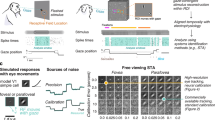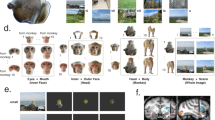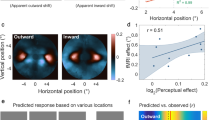Abstract
How are objects represented in the brain during natural behavior? Visual object recognition in primates is thought to depend on the inferotemporal cortex (IT). In most neurophysiological studies of IT, monkeys hold their direction of gaze fixed while isolated visual stimuli are presented (controlled viewing). However, during natural behavior, primates visually explore cluttered environments by changing gaze direction several times each second (free viewing). We examined the effect of free viewing on IT neuronal responses in monkeys engaged in a form-recognition task. By making small, real-time stimulus adjustments, we produced nearly identically retinal stimulation during controlled and free viewing. Nearly 90% of neuronal responses were unaffected by free viewing, and average stimulus selectivity was unchanged. Thus, neuronal representations that likely underlie form recognition are virtually unaltered by free viewing.
This is a preview of subscription content, access via your institution
Access options
Subscribe to this journal
Receive 12 print issues and online access
$209.00 per year
only $17.42 per issue
Buy this article
- Purchase on Springer Link
- Instant access to full article PDF
Prices may be subject to local taxes which are calculated during checkout







Similar content being viewed by others
References
Tanaka, K. Inferotemporal cortex and object vision. Annu. Rev. Neurosci. 19, 109–139 (1996).
Miyashita, Y. Inferior temporal cortex: where visual perception meets memory. Annu. Rev. Neurosci. 16, 245–263 (1993).
Booth, M. C. A. & Rolls, E. T. View-invariant representations of familiar objects by neurons in the inferior temporal visual cortex. Cereb. Cortex 8, 510– 523 (1998).
Sugase, Y., Yamane, S., Ueno, S. & Kawano, K. Global and fine information coded by single neurons in the temporal visual cortex. Nature 400, 869–873 ( 1999).
Missal, M., Vogels, R., Li, C. & Orban, G. A. Shape interactions in macaque inferior temporal neurons. J. Neurophysiol. 82, 131–142 (1999).
Rollenhagen, J. E. & Olson, C. R. Mirror-image confusion in single neurons of the macaque inferotemporal cortex. Science 287, 1506–1508 ( 2000).
Gibson, J. R. & Maunsell, J. H. R. The sensory modality specificity of neural activity related to memory in visual cortex. J. Neurophysiol. 78, 1263–1275 ( 1997).
Findlay, J. Active vision: Visual activity in everyday life. Curr. Biol. 8, R640–R642 (1998).
Motter, B. C. & Belky, E. J. The zone of focal attention during active visual search. Vision Res. 38, 1007 –1022 (1998).
Sommer, M. A. Express saccades elicited during visual scan in the monkey. Vision Res. 34, 2023–2038 ( 1994).
Burman, D. D. & Segraves, M. A. Primate frontal eye field activity during natural scanning eye movements. J. Neurophysiol. 71, 1266–1271 (1994).
Ballard, D. Animate vision. Artificial Intelligence 48, 57–86 (1991).
Dawkins, M. S. & Woodington, A. Pattern recognition and active vision in chickens. Nature 403, 652–655 (2000).
Gallant, J. L., Connor, C. E. & Van Essen, D. C. Neural activity in areas V1, V2 and V4 during free viewing of natural scenes compared to controlled viewing. Neuroreport 9, 2153–2158 ( 1998).
Livingstone, M. S., Freeman, D. C. & Hubel, D. H. Visual responses in V1 of freely viewing monkeys . Cold Spring Harb. Symp. Quant. Biol. 61, 27–37 (1996).
Vinje, W. E. & Gallant, J. L. Sparse coding and decorrelation in primary visual cortex during natural vision. Science 287, 1273–1276 (2000).
Guido, W. & Weyand, T. Burst responses in thalamic relay cells of the awake behaving cat. J. Neurophysiol. 74 , 1782–1786 (1995).
Judge, S. J., Wurtz, R. H. & Richmond, B. J. Vision during saccadic eye movements. I. Visual interactions in striate cortex. J. Neurophysiol. 43, 1133–1155 (1980).
Vogels, R. & Orban, G. A. Activity of inferior temporal neurons during orientation discrimination with successively presented gratings. J. Neurophysiol. 71, 1428–1451 (1994).
Liu, Z. & Richmond, B. J. Response differences in monkey TE and perirhinal cortex: stimulus association related to reward schedules . J. Neurophysiol. 83, 1677– 1692 (2000).
Logothetis, N. K. & Sheinberg, D. L. Visual object recognition. Annu. Rev. Neurosci. 19, 577 –621 (1996).
Gochin, P. M., Colombo, M., Dorfman, G. A., Gerstein, G. L. & Gross, C. G. Neural ensembly coding in inferior temporal cortex. J. Neurophysiol. 71, 2325 –2337 (1994).
Britten, K. H., Shadlen, M. N., Newsome, W. T. & Movshon, J. A. The analysis of visual motion: a comparison of neuronal and psychophysical performance. J. Neurosci. 12, 4745– 4765 (1992).
Felleman, D. J. & Van Essen, D. C. Distributed hierarchical processing in the primate cerebral cortex. Cereb. Cortex 1, 1–47 ( 1991).
Ross, J., Burr, D. & Morrone, C. Suppression of the magnocellular pathway during saccades . Behav. Brain Res. 80, 1– 8 (1996).
Diamond, M. R., Ross, J. & Morrone, M. C. Extraretinal control of saccadic suppression. J. Neurosci. 20, 3449–3455 (2000).
Castet, E. & Masson, G. S. Motion perception during saccadic eye movements. Nat. Neurosci. 3, 177– 183 (2000).
Ungerleider, L. G. & Mishkin, M. in Analysis of Visual Behavior (eds. Ingle, D. J., Goodale, M. A. & Mansfield, R. J. W.) 549–585 (MIT Press, Cambridge, Massachusetts, 1982).
Maunsell, J. H. R., Nealey, T. A. & DePriest, D. D. Magnocellular and parvocellular contributions to responses in the middle temporal visual area (MT) of the macaque monkey. J. Neurosci. 10, 3323–3334 (1990).
Colby, C. L. & Goldberg, M. E. Space and attention in parietal cortex. Annu. Rev. Neurosci. 22, 319– 349 (1999).
Ferrera, V. P., Nealey, T. A. & Maunsell, J. H. R. Responses in macaque visual area V4 following inactivation of the parvocellular and magnocellular LGN pathways. J. Neurosci. 14, 2080–2088 (1994).
Leopold, D. A. & Logothetis, N. K. Microsaccades differentially modulate neural activity in the striate and extrastriate visual cortex. Exp. Brain Res. 123, 341– 345 (1998).
Ringo, J. L., Sobotka, S., Diltz, M. D. & Bunce, C. M. Eye movements modulate activity in hippocampal, parahippocampal, and inferotemporal neurons. J. Neurophysiol. 71, 1285– 1288 (1994).
Maunsell, J. H. R. The brain's visual world: representation of visual targets in cerebral cortex . Science 270, 764–769 (1995).
Desimone, R. & Duncan, J. Neural mechanisms of selective visual attention. Annu. Rev. Neurosci. 18, 193– 222 (1995).
Vega-Bermudez, F., Johnson, K. O. & Hsiao, S. S. Human tactile pattern recognition: active versus passive touch, velocity effects, patterns of confusion. J. Neurophysiol. 65, 531–546 ( 1991).
Robinson, D. A. A method of measuring eye movements using a scleral search coil in a magnetic field. IEEE Trans. Biomed. Eng. 101, 131 –145 (1963).
Bahill, A., Clark, M. & Stark, L. Glissades—eye movements generated by mismatched components of the sacadic motorneuronal control signal. Math. Biosciences 26, 303–318 ( 1975).
Martinez-Conde, S., Macknik, S. L. & Hubel, D. H. Microsaccadic eye movements and firing of single cells in the striate cortex of macaque monkeys. Nat. Neurosci. 3, 251–258 ( 2000).
Snedecor, G. W. & Cochran, W. D. Statistical Methods (Iowa Univ. Press, Ames, Iowa, 1967).
Gur, M. & Snodderly, D. M. Studying striate cortex neurons in behaving monkeys: benefits of image stabilization. Vision Res. 27, 2081–2087 ( 1987).
Baylis, G. C., Rolls, E. T. & Leonard, C. M. Functional subdivisions of the temporal lobe neocortex . J. Neurosci. 7, 330–342 (1987).
Acknowledgements
We thank C. Boudreau, E. Cook, G. Ghose, and T. Yang for discussions on design, analysis and presentation, and D. Murray for animal husbandry. We also thank K. Johnson and D. Sparks for comments on a previous version of this manuscript. This work was supported by NIH EY05911. J.H.R.M. is an Investigator with the Howard Hughes Medical Institute.
Author information
Authors and Affiliations
Corresponding author
Rights and permissions
About this article
Cite this article
DiCarlo, J., Maunsell, J. Form representation in monkey inferotemporal cortex is virtually unaltered by free viewing. Nat Neurosci 3, 814–821 (2000). https://doi.org/10.1038/77722
Received:
Accepted:
Issue Date:
DOI: https://doi.org/10.1038/77722
This article is cited by
-
Generalization in vision and motor control
Nature (2004)
-
Shape-coding in IT cells generalizes over contrast and mirror reversal, but not figure-ground reversal
Nature Neuroscience (2001)
-
Eyes of the world be free; you have nothing to lose but your chains
Nature Neuroscience (2000)



